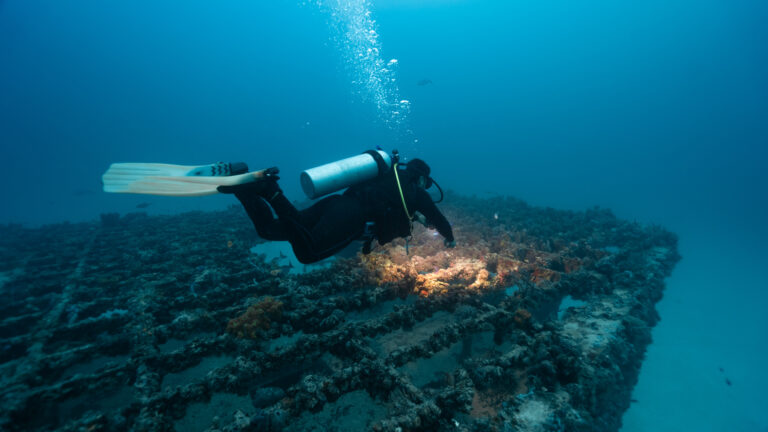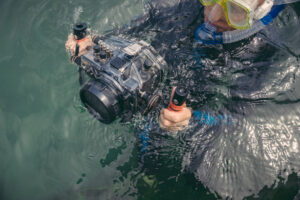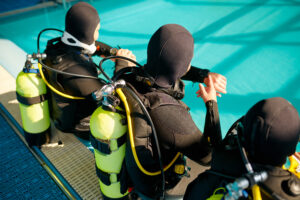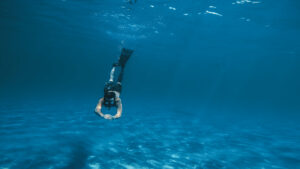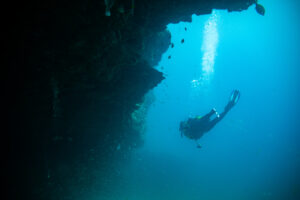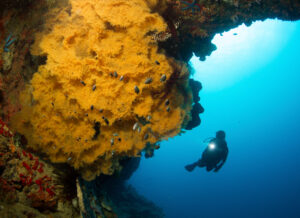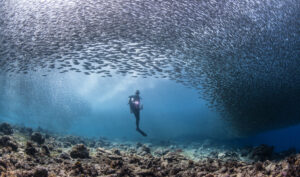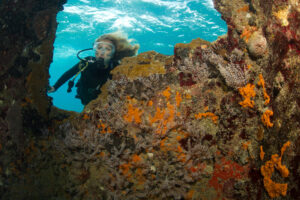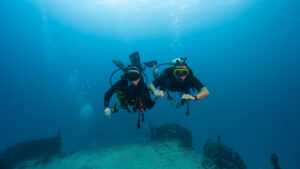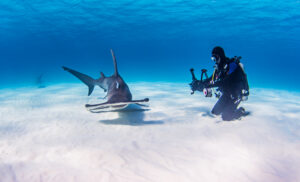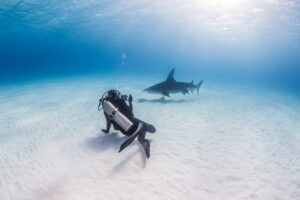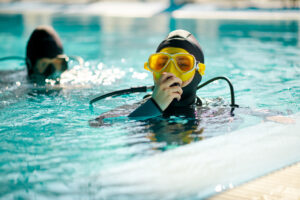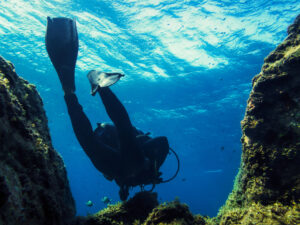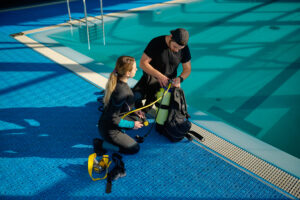What is a Pressure Gradient?
In scuba diving, understanding the concept of a pressure gradient is crucial for ensuring safety and effective dive planning. A pressure gradient refers to the change in pressure per unit distance within a fluid. In the context of diving, this typically means the variation in water pressure as a diver moves vertically through the water column. This phenomenon is essential because it affects everything from buoyancy control to the physiological impacts on the diver’s body.
Basic Principles of Pressure in Fluids
Pressure is defined as the force exerted per unit area. In a fluid medium such as water, pressure increases with depth due to the weight of the water above. This is a direct result of gravity pulling the water down, causing the molecules to exert more force on those below. At sea level, the pressure is 1 atmosphere (atm), and for every 10 meters (32.8 feet) of descent in seawater, the pressure increases by approximately 1 atm.
In scuba diving, this principle is fundamental. As a diver descends, they experience a significant increase in pressure. For example, at a depth of 20 meters (65.6 feet), the pressure is about 3 atm: 1 atm from the atmosphere and 2 atm from the water column. Understanding this increase is critical for managing the effects on the body and diving equipment.
The concept of a gradient in this context refers to the rate at which pressure changes with depth. A steep gradient means a rapid change in pressure over a short distance, while a shallow gradient indicates a more gradual change. This variation influences how divers plan their descents and ascents to avoid potential hazards like decompression sickness.
Pressure Gradient: Definition and Calculation
A pressure gradient is the rate of pressure change relative to distance. Mathematically, it is expressed as the change in pressure (ΔP) divided by the change in depth (Δd). For divers, this is often calculated as the pressure difference between two points divided by the vertical distance separating them.
For instance, if the pressure at 10 meters (32.8 feet) is 2 atm and at 20 meters (65.6 feet) is 3 atm, the pressure gradient between these depths is (3 atm – 2 atm) / (20 meters – 10 meters), which equals 0.1 atm per meter. This calculation helps divers understand how quickly pressure changes in their environment, allowing them to adjust their behavior accordingly.
Typical pressure gradients in scuba diving vary depending on the dive site and conditions. In deeper waters, the gradient can become more pronounced, necessitating careful monitoring. Understanding these gradients is essential for planning dives, especially when considering the effects of pressure on gas absorption and buoyancy.
Role of Pressure Gradients in Scuba Diving
Pressure gradients play a pivotal role in various aspects of scuba diving, influencing buoyancy, equipment function, and physiological effects on the diver. Buoyancy is directly affected by pressure gradients. As a diver descends, the increased pressure compresses the air in their buoyancy control device (BCD) and wetsuit, reducing buoyancy. Conversely, ascending decreases pressure, causing the air to expand and increase buoyancy. Proper weight adjustments are necessary to maintain neutral buoyancy throughout the dive.
Diving equipment is also significantly impacted by pressure gradients. Buoyancy control devices, dry suits, and regulators must function reliably under varying pressures. For example, BCDs need to allow for precise control of buoyancy as the diver ascends or descends, accommodating the changing pressure gradients. Similarly, dry suits must maintain insulation and buoyancy characteristics despite compression at greater depths.
Pressure gradients also influence gas behavior, particularly the expansion and contraction of gases in a diver’s body and equipment. This is crucial for dive planning and gas management. As divers descend, the increased pressure causes gases to dissolve into their tissues more rapidly, increasing the risk of decompression sickness if not managed properly. Conversely, as they ascend, the decreasing pressure allows gases to expand, potentially forming harmful bubbles if the ascent is too rapid.
Managing Pressure Gradients
Managing the risks associated with pressure gradients involves several techniques and safety procedures. One of the primary methods is controlling ascent and descent rates. Rapid changes in depth can cause dangerous pressure differentials, so divers are trained to ascend slowly, typically no faster than 9 meters (30 feet) per minute. This allows time for gases dissolved in the body to safely dissipate.
Safety stops are another critical practice for managing pressure gradients. During a safety stop, typically performed at 5 meters (16.4 feet) for three to five minutes, divers pause their ascent to allow additional time for off-gassing. This helps prevent decompression sickness by providing a gradual reduction in pressure, allowing inert gases to be safely eliminated from the body.
Dive profiles and dive computers are essential tools for managing pressure gradients. Dive computers provide real-time data on depth, time, and decompression status, helping divers adhere to safe ascent rates and decompression limits. Modern dive computers also account for multi-level dives and variable ascent rates, offering personalized guidance based on the diver’s profile.
Real-World Applications and Case Studies
Real-world examples highlight the importance of understanding and managing pressure gradients. In one case study, a group of divers experienced decompression sickness after a deep dive with rapid ascent. Analysis revealed that the steep pressure gradient during their ascent caused nitrogen bubbles to form in their tissues, leading to symptoms like joint pain and dizziness. Proper ascent techniques and adherence to safety stops could have mitigated these risks.
Specialized diving scenarios, such as cave diving and wreck penetration, further illustrate the role of pressure gradients. In these environments, divers often encounter narrow passages and confined spaces, where pressure changes can be abrupt. Managing buoyancy and ascent rates in such conditions requires advanced skills and careful planning to avoid hazardous pressure differentials.
Technical diving, which involves deeper and longer dives, also underscores the importance of pressure gradients. Technical divers use mixed gases and decompression procedures to manage the increased pressures encountered at greater depths. Understanding pressure gradients is crucial for planning gas mixtures, decompression schedules, and emergency protocols.
Recent Advances and Research
Recent advances in dive science and technology have enhanced our understanding of pressure gradients and their impact on diving safety. Research on decompression models and gas dynamics has led to improved algorithms for dive computers, providing more accurate and personalized decompression data. These advancements help divers manage pressure gradients more effectively, reducing the risk of decompression sickness.
Innovations in dive equipment, such as advanced BCDs and dry suits, have also improved diver safety. Modern BCDs offer better buoyancy control, allowing divers to adjust to changing pressure gradients more precisely. Advanced dry suits maintain thermal insulation and buoyancy characteristics at depth, enhancing comfort and safety.
Ongoing research continues to explore the physiological effects of pressure gradients on divers. Studies on bubble formation and gas absorption provide insights into preventing decompression sickness and other pressure-related conditions. This research contributes to safer diving practices and improved training protocols, emphasizing the importance of understanding pressure gradients in diving.
Key Takeaways
Understanding pressure gradients is essential for safe and effective scuba diving. These gradients influence buoyancy, equipment function, and physiological effects on the diver. Proper management techniques, such as controlled ascent rates and safety stops, help mitigate the risks associated with pressure changes. Advances in dive science and technology continue to enhance our understanding and management of pressure gradients, contributing to safer diving practices and improved diver training. By respecting the principles of pressure gradients, divers can enjoy safer and more enjoyable underwater experiences.

